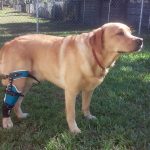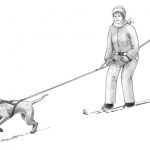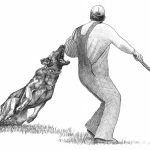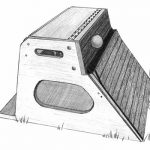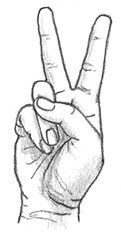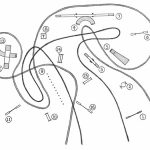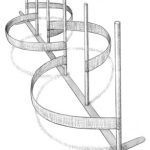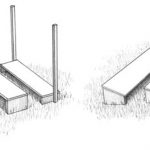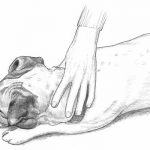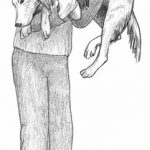- Figuring out commands for your dog’s safety (and the safety of others)
- Mastering commands for your convenience (and the convenience of others)
Remembering to never say no with your dog
Your lifestyle dictates the commands most important for you and your dog, and you may not need all of them we include in this chapter. Nor does the order in which we list them necessarily reflect their relative importance to you. Chapter
Mastering Basic Training contains the information you need to train Buddy to respond to these commands.
Sit — The Safety Command
Permitting Buddy to barge uncontrollably through doorways isn’t a good idea — you may get mowed down in the process. Get into the habit of making Buddy sit before you open a door. After he sits, it doesn’t matter whether you release him to go through first, or whether you go first and then release him, so long as he sits until you tell him it’s okay to move.
Similarly, make him wait before you go up or down stairs, or get in and out of the car.
Sit — The Convenience Command
The “Sit” command lets you control Buddy during periods of excitement, such as the happy greeting when you return home, when visitors arrive, and when you’re about to take him for a walk and want to put his collar and leash on. “Sit” is also the easiest way to stop Buddy from jumping on people.
Remember
One question we frequently are asked is, “He doesn’t jump on me anymore, but how do I get him to stop jumping up on visitors?” Our advice is to enlist the help of friends and neighbors to train Buddy. Show the visitor how to induce Buddy into a Sit with a treat and the command, and then reward him with a treat. Ask as many people as you can to help you. It won’t take Buddy long before he’ll sit on his own in front of a visitor in expectation of his treat. At that point, you no longer need to give him a treat every time he responds correctly. A “good dog” with a scratch under the chin will suffice.
Stay
You use the “Stay” command when you want Buddy to remain in one position — Sit, Stand, or Down — until you tell him he can move again. Generally, the length of time you want him to stay in position is relatively short, no more than five to ten minutes. The key to its value is that he has to learn to stay until you release him. After he gets into the habit of releasing himself, the command has lost its usefulness. One example of when to use this command is when you feed your dog. Before putting his bowl down, tell him to “Sit” and “Stay.” Put his bowl down, count to five, and then release him with “Okay.”
Go Lie Down
Telling your dog to “Go Lie Down” is another command of convenience. During mealtimes, you don’t want Buddy hanging out by the table. The “Go Lie Down” command tells him to chill out in his favorite spot until you’re done, or when you have guests and he insists on making a nuisance of himself.
Come
“Come” is as much a command of convenience as of safety. You need this command any time you want Buddy to come to you for whatever reason — after he has enjoyed a nice romp in the park or when he is chasing a cat. Unless he responds reliably to the “Come” command, you need to keep him on leash in situations where he might be a danger to others or himself.
Easy
Give
The “Give” command is useful for taking something out of Buddy’s mouth that you don’t want him to have and that he doesn’t want to give up. The object can be anything, from one of your favorite possessions to the piece of meat he has just stolen off the counter.
Remember
Our favorite way of getting Buddy to give up whatever he has in his mouth is to trade — we offer him a treat in exchange for what he has in his mouth. If he has food, you may have to offer him something of equal value, such as a frozen chicken wing. We keep these in our freezer at all times because we use them as special treats. Of course, sometimes you don’t have a treat handy, in which case you just have to open his mouth and remove the object.
Off
“Off” is a commonly used command for getting the dog off the furniture. The command is also frequently used to stop dogs from jumping on people, although “Sit” is a better choice because it’s more specific.
Whether you allow your dog on the furniture is a matter of personal preference. You can certainly train him to stay on the floor, at least as long as you’re in his presence. Chances are, however, that when you’re gone, he’ll settle on his favorite couch only to quietly slide off when he hears you coming home.
For those individuals who are adamant about keeping the dog off the furniture, there are several options:
– Don’t give him the run of the house.
– Place a broomstick on Buddy’s favorite chair or couch while you’re gone. The broomstick works well with most dogs, although we know of instances where the dog simply removed the stick.
– Invest in one or more Scat Mats. Scat Mats come in different sizes and are designed to keep dogs and cats off the furniture by giving the animal a slight electric shock when it steps on it. The intensity of the shock can be regulated.
Scat Mats are also used to restrict access to a room or part of the house. Again, the device isn’t foolproof, because some dogs figure out that they can jump over the mat.
The latest entry into pet containment approaches is the Innotek Instant Pet Barrier (www.innoteck.net). This device uses the same principle as the outdoor electronic fence to confine the dog within a certain room or area within the house.
Leave It
“Leave It” is another common command that tells the dog to ignore whatever interests him at the time. The object of his interest can be a cat, another dog, a person, or something on the ground.
No “No” Command
Our least favorite command is “No.” We prefer to tell the dog exactly what it is we want him to do with an action command, such “Come,” “Sit,” or “Down.” When the dog responds, we can then praise him by telling him how good he is.
Remember
“No” is nebulous, negative, and overused, and most of the time doesn’t give the dog any specific instruction or directive. Worse yet, “No” doesn’t generally lend itself to being followed by praise. For example, Buddy wants to jump on you, you yell “No,” and he stops. Can you now praise him? No, because he may still be thinking about jumping on you and praising him encourages him to try again, not the message you want to give.
All in all, eliminate the word from your communications with Buddy. Of course, in an emergency, you do what you have to.
by Jack and Wendy Volhard









